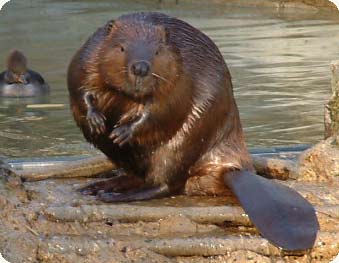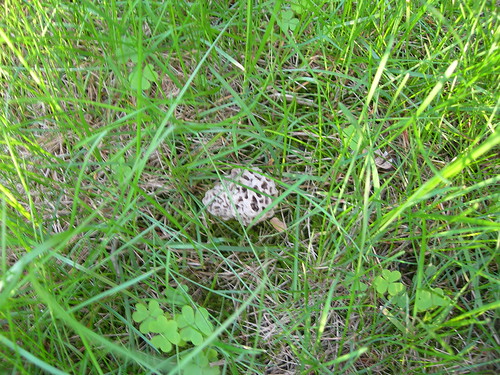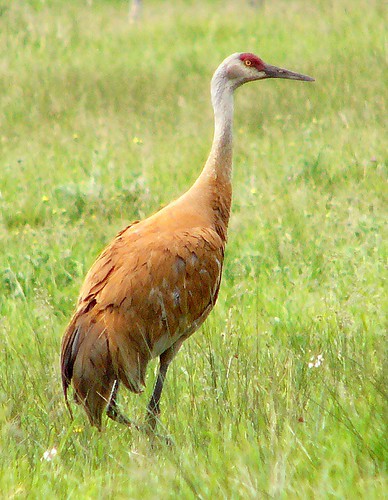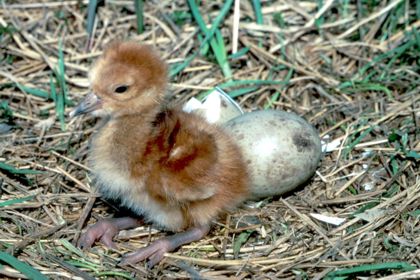
9:24 p.m. - 2006-04-29
Sandhill Cranes.
Dear Creature Seekers,
Hello! Greetings from Diaryland! It's been a busy few weeks, with a sinus infection, a performance, the end of the semester, and crazy stuff at my other job.
And the animals have been busy too! Robert and I spotted more turtles, along with many geese, including one goose sitting cozily on a nest under a tree. KB reports a muskrat sighting in Richfield, and SH shares amazing news: The Mother of all Beavers lives in the Minnehaha creek under the Nokomis Avenue Bridge!
SH, we must find this mighty beaver!
In the fungus report, keep your eye out for morel mushrooms! They grow under dead elm trees. My parents found exactly 100 in south central Wisconsin yesterday. If you find morels, make sure to clean them thoroughly (soak in salted water) and cook them until browned (they shouldn't be eaten raw). Disclaimer: Don't eat wild mushrooms unless you can positively identify them as edible.
Yumsters!
My handsome cousin JS wrote me several weeks ago, with a critter request. So, a creature new to the Critter Corner: The Sandhill Crane!
The sandhill crane (Grus canadensis) and rarer whooping crane are the two crane species that call America home; there are fifteen species total worldwide.
These birds are big! While there are six subspecies of sandhill cranes, the average crane is about four to five feet high, with a body 36 inches long, an 80 inch wingspan, and a weight of nine to twelve pounds!
Side note: My Dad calls sandhill cranes "Corn Storks".
Cranes DO like corn! In fact, they dig up freshly planted kernels, to the chagrin of many a farmer. Sandhills also enjoy other grains, including waste grains left over in the spring. On the positive side, they also eat troublesome insects in cultivated fields, too. With their long beaks, sandhill cranes dig in the ground for roots and worms, and also eat snails, mice, crayfish, birds, frogs and snakes!
Cranes are true omnivores.
Side note: Omnivores just like R and I this morning, as we pillaged the brunch spread at our local "Old Country Buffet"!
Sandhill cranes can be identified by their greyish color, red head, and the "bustle-like" tertiary feathers hanging down their booty. The birds also have a distinctive and loud call!
There is a biological reason for the richness and loudness of cranetalk; apparently instead of having a straight windpipe like most creatures, the crane's trachea actually loops around in a circle. This loop fits into a special cavity within the bird's sternum, and accounts for its vocal power!
Cranes use these cries for love, of course. The mating or "unison" call of sandhill cranes is legendary. During the bird's courtship period, males and females sing in synchronicity, with females calling twice for every call of the male. There is also a physical display of love, which involves bowing, stick tossing and jumping. This display is also used outside of mating season to bond together as a flock
and to discourage aggression between cranes.
Upon returning from migration, the cranes immediately secure a partner (if they aren't already with their life-mate) and a brooding territory. This can range from 10 to 200 acres, and the birds protect it viciously from other cranes. Mama crane builds a nest about two to three feet in diameter, and lays two brownish-green eggs, about twice the size of chicken eggs. The eggs are laid 12 to 48 hours apart, and often the older chick kills its baby sibling as it emerges. Yikes! The babies start flying ten weeks later, and will stay with their parents until the next spring. Check out this baby pic!
As summer wanes, the previously territorial sandhill crane pairs become more social, gathering into progressively larger groups as the fall migration occurs. There are several paths the cranes take throughout the U.S.; the largest "crossroads" in the midwest is at the Jasper-Pulaski State Fish and Game Area near Radioville Indiana. About 30,000 cranes from WI, Ontario, MN, and MI stop over on their way south. Cool!
Baraboo, WI has a special haven for cranes, the International Crane Foundation. Check them out! You can hear sandhill crane calls on their site, along with much more detailed info than I can provide.
Side note: I also purchased my wedding dress in Baraboo for $319! (Well, my Mom did....)
Well, I hope we spot some sandhill cranes this summer! Remember, herons fly with bent necks, and cranes with straight ones. Here's a final pic :
Cousin JS, thanks for the Critter Request!
Mating calls,
Wendell!
P.S. Any baby bunny sightings yet? :(




